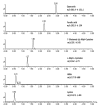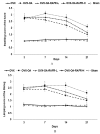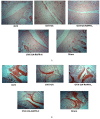Rice Porridge Containing Welsh Onion Root Water Extract Alleviates Osteoarthritis-Related Pain Behaviors, Glucose Levels, and Bone Metabolism in Osteoarthritis-Induced Ovariectomized Rats
- PMID: 31262076
- PMCID: PMC6683264
- DOI: 10.3390/nu11071503
Rice Porridge Containing Welsh Onion Root Water Extract Alleviates Osteoarthritis-Related Pain Behaviors, Glucose Levels, and Bone Metabolism in Osteoarthritis-Induced Ovariectomized Rats
Abstract
Rice porridge containing Allium fistulosum (Welsh onion) root water extract (RAFR) has anti-inflammatory bioactive compounds. We examined whether the long-term administration of rice porridge with RAFR would prevent or delay the progression of osteoarthritis and menopausal symptoms in estrogen-deficient animals by ovariectomy. The rats consumed 40% fat energy diets containing 250 mg RAFR (rice: Allium fistulosum root = 13:1)/kg body weight (bw) (OVX-OA-RAFR-Low), 750 mg RAFR/kg bw (OVX-OA-RAFR-High) and 750 mg starch and protein/kg bw(OVX), respectively. After consuming the assigned diets for eight weeks, monoiodoacetate (OVX-OA) or saline (OVX) were injected into the knee joints of the rats for an additional three weeks. Sham rats were administered saline injections (normal-control). OVX-OA-RAFR improved oral glucose tolerance and also protected against decreases in bone mineral density and lean body mass in the legs and increases in fat mass in the abdomen, compared to the OVX and OVX-OA. OVX-OA-RAFR improved swelling and limping scores, normalized weight distribution between the osteoarthritic and normal limbs, and increased maximum running speeds compared to the OVX-OA. The OVX-OA deteriorated the articular cartilage by reducing the articular matrix and bone loss in the knee joint and it prevented knee joint deterioration when compared to the OVX. The improvement in osteoarthritis symptoms in OVX-OA-RAFR decreased the mRNA expression of matrix metallo-proteinase-1 and matrix metalloproteinase-13, tumor necrosis factor-α, and interleukin-1β and interleukin-6 in the articular cartilage compared to OVX-OA rats. In conclusions, RAFR is effective in treating osteoarthritis symptoms and it may be used for a therapeutic agent in osteoarthritis-induced menopausal women.
Keywords: Welsh onion root; estrogen-deficiency; inflammation; osteoarthritis; pain; rice porridge.
Conflict of interest statement
The authors declare no conflicts of interest.
Figures











References
-
- Cross M., Smith E., Hoy D., Nolte S., Ackerman I., Fransen M., Bridgett L., Williams S., Guillemin F., Hill C.L., et al. The global burden of hip and knee osteoarthritis: Estimates from the global burden of disease 2010 study. Ann. Rheum. Dis. 2014;73:1323–1330. doi: 10.1136/annrheumdis-2013-204763. - DOI - PubMed
MeSH terms
Substances
Grants and funding
LinkOut - more resources
Full Text Sources
Medical

